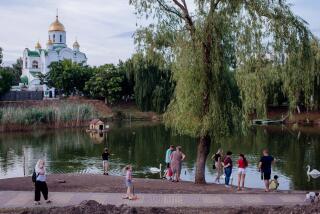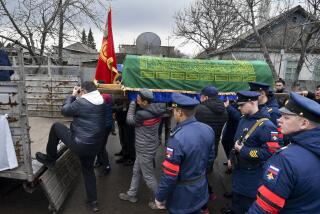Trying to Retrieve What God Lost : Siberia’s Riches Immense, but So Are Costs, Soviets Find
- Share via
YAKUTSK, U.S.S.R. — When God created the Earth, he filled a bag with gold and silver and diamonds and oil, intending to spread the riches equally among the peoples of the world.
But, according to Yakutian lore, when he flew over Russia he got so cold that his hands froze and he dropped the sack, forever spilling the world’s wealth across one of the most barren regions of the globe--Siberia.
The Soviet Union today is trying to retrieve what God lost.
Doors 3 Layers Thick
With promises of better pay, private cars, new apartments and lengthy vacations, the Soviets are trying to lure workers to a part of the world where doors and windows have to be three layers thick, where schools close when temperatures hit 50 degrees below zero, and where “ice fog” coats the towering statue of Lenin with powdery white ice.
Historically, the Soviet Union’s natural resources have made it an international power, but those resources that were easily exploited or in better climates are either exhausted or inadequate. The search for new sources has turned inevitably to this spot more than 3,000 miles and six time zones from Moscow.
The 1.2-million-square-mile Autonomous Soviet Socialist Republic of Yakutia--nearly eight times the size of California--boasts an array of resources few places on Earth can match.
Gold mining has been under way for 60 years. Diamonds come from three different mines. Oil and gas are tapped for local needs and reserves could be the largest in the Soviet Union, already the world’s leading producer. Other minerals include copper, lead, zinc and mica.
Industrial Zone
Showpiece of the development is the complex around Neryungri, 400 miles south of the regional capital at Yakutsk and site of a gaping open-pit coal mine that eventually will be the heart of an industrial zone turning nearby iron into steel.
“I came here in 1975 and it was completely forest, taiga all around,” said Pyotr Fyodorov, mayor of Neryungri. “Now it is a 60,000-strong city.” Almost an equal number live in settlements around the town.
Where a few geologists’ tents once stood, the mine aims to remove 13 million tons of coal this year, and a new power plant pumps steam into the frigid Siberian air.
It has been a classic Soviet project. Once the decision was made in Moscow, all resources were mobilized. Thousands of workers were assigned, scarce equipment was diverted from other areas and construction went on around the clock.
A new factory turns out slabs for prefabricated buildings that rise from the permafrost-dotted land in a matter of months. Gaunt steel frames of new factories stand nearby, indistinct in the icy mist.
Soviet planners see this as the first of a string of industrial centers defying the vast distances and nature’s hostility in the resource-rich Soviet east.
But if the riches of Siberia are immense, so are the costs--now and probably forever. Everything in this forbidding region costs the state drastically more, from workers’ salaries to the equipment they use, the food they eat and the houses they live in.
Yevgeni Varshovski, 50, the chief of construction who has been on the project since the start, said the Neryungri development has cost $2.6 billion so far, helped by a Japanese loan of $450 million being repaid in coal exports. Those figures, however, pale against costs of the future.
Plans call for extension of a rail spur connecting to the Baikal-Amur Mainline railway, itself just completed last year at a reported cost of $39 billion.
The new line, now just south of Neryungri, would reach Yakutsk by 1995. There is even a plan for continuing the line through even more hostile terrain, to the isolated Pacific port of Magadan.
As can be said of all progress in Siberia, the climate is the most formidable opponent.
According to Soviet officials, punishingly low temperatures push the cost of housing 3 1/2 times above the Moscow level, salaries more than double. State farms sell meat for half the cost of production.
When the thermometer hits minus-40 degrees, some mine equipment stops moving, although it can never be turned off. When it hits minus-50, schools close and outdoor work halts.
Yakutsk Even Colder
This is not rare: The temperature hovered in the minus-50 range in Neryungri for two weeks last winter. Yakutsk is even colder, shrouded for much of the winter in the dense ice mist.
To get workers to accept the conditions, the government has offered such incentives as higher wages, longer vacations, bonuses for staying and priority in getting a private car. But more is needed, and the government knows it.
Officials boast of building apartments, schools, theaters, swimming pools and other comforts in a city where outdoor activity is severely curtailed. But they also admit that there is a 3 1/2-year wait in temporary wooden housing before moving to a new apartment.
“If we don’t solve this problem it will be hard to provide the work force for the region,” said Nikolai Chersky, head of the Yakutsk branch of the Soviet Academy of Sciences, who has lived in Yakutia for 33 years.
‘Only the Weak Leave’
Still, for those who are there, there is a certain bravado. Outsiders are typically told, “Only the weak leave.”
In the never-ending battle against the cold, doors and windows are made three layers thick. Walls are thicker, water and sewage pipes are heated and, most important, builders must deal with permafrost just beneath the surface. The frozen earth extends down to 4,750 feet, the deepest found anywhere on earth.
Builders must avoid constructing anything that will melt the permafrost, placing buildings atop stilts to keep the earth frozen. Wildly undulating floors of old, ground-touching wooden structures testify to the consequences of turning the frozen earth to mud.
Vehicles cannot be turned off for fear they will not restart. Anyone breathing too quickly is in danger of freezing his lungs. Two area villages have registered temperatures of minus-94.
“For us, there is a saying,” Varshovski said. “June is not yet summer, and by July summer is already past.”
Indeed, in Neryungri it snows from September to May. The brief summer, which sends temperatures soaring into the 90s, draws more complaints than the winter.
In Yakutia, about 300 miles south of the Arctic Circle, a large statue of Lenin in front of party offices is barely visible through the ice fog that shrouds the city for weeks at a time.
Despite the hardships, efforts to build the area are succeeding.
The 1 millionth citizen of Yakutia was born last November. The population continues to grow well ahead of the national rate.
Nine-Month Cucumbers
Greenhouses struggle to produce fresh vegetables. Residents in Neryungri boast they now have cucumbers nine months of the year.
Reindeer and ponies raised by the natives for meat are better suited to the climate, but fodder is imported to raise dairy cows, cattle and hogs in barns.
The easiest adjustment comes from people themselves. With warm clothing, a careful watch for frostbite and a rugged constitution, residents of east Siberia survive their famous cold without trouble. Some even enjoy it.
“Every day before I go out, I take ice in a cloth and massage my face,” said Nina Nikin, relating a beauty secret to visitors to Neryungri. “In the summer I take ice from the refrigerator.”
More to Read
Sign up for Essential California
The most important California stories and recommendations in your inbox every morning.
You may occasionally receive promotional content from the Los Angeles Times.













